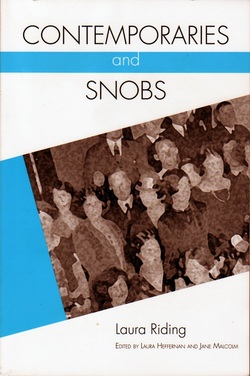
Contemporaries and Snobs was first published by Doubleday Doran in 1928, during the period (1925-30) of Riding’s most influential presence in the international high modernist writing scene. It was a time in which she published poetry and commentary in major modernist journals, was in contact with Gertrude Stein, Wyndham Lewis and T.S. Eliot, lived with Robert Graves and co-wrote with Graves A Survey of Modernist Poetry (1927), which the editors of this volume describe as the “first formal study to consider the work of E.E. Cummings, Hart Crane, Conrad Aitken, Marianne Moore, Ezra Pound, Vachel Lindsay, T.S. Eliot, John Crow Ransom, Edith Sitwell, and Allen Tate as a single movement” (xi).
There is no surprise in its being republished: it’s an important document not only of the male dominance of that literary scene but also of the conflicts within it that are often understated in literary histories. There is perhaps some mystery in it being republished within Alabama’s “Modern/Contemporary” Poetics series edited by Charles Bernstein and Hank Lazer. Is there a connection being implied between the literary politics of the 1920s and those of recent US poetry? Are Riding’s acid criticisms of Eliot’s self-canonizing essays and her perceptive readings of Stein being reframed in order also to reframe the various works of Language poets?
However what could impress a reader first in Riding’s book is how distant her assumptions are from those in contemporary poetry. While challenging Eliot’s emphasis on ridding poetry of the personal and subjective, his stress on impersonality, she also readily accepts his implication that literature and literary periods can be only classical or romantic, and uses it to construct a history of English literature and Western culture as an oscillation of classical and
When humanity or a co-ordinated representative portion of humanity attempts to observe the absolute as strictly as possible in whatever form it is officially recognized at the time, and to compare its own relativeness with it continually, then we have a coherent time-length; we have classicism. When humanity falls in love with its own relativeness and ceases to compare its variability with an absolute, then we have romanticism. (69)
She is suspicious of what she calls “the Zeitgeist” (shades of Pound’s “the age demanded”) and of critical calls for poets to reflect or express it their writing – “What is all current literary modernism but the will to extract the literary sense of the age from the Zeitgeist at any cost to creative independence” (1) and is seemingly unaware that the dialogue she has launched here with Eliot, Joyce, Stein and others may be itself part of a time- and space-bound cultural phenomenon. She repeatedly defends “independence” and “eccentricity” in poetry, which she sees threatened by high modernist prescriptions, but has no explanation of how her sui generis “true poets” could indeed be eccentric relative to ‘poetry’ or to one another.
But there are at least two aspects of the book that are likely to engage today’s reader. One is the vigour of her disdain for high modernism, and the often sarcastic wit of her criticisms.
Since poetry was to write about nothing, it could write about everything from the standpoint of nothing; it could still have its epic without the burden of having to have convictions about it. (8) [re Eliot and The Waste Land]
James Joyce, ... by a colossal evasion, which involved swallowing the Zeitgeist and then vomiting it up again, accomplished the dual and monstrous feat of capitulation and revolt in one huge, involuntary reflex-spasm. (12)
The expressionist is a personal victim, expressionism a critical device of the Zeitgeist for allowing its victim to extinguish itself. (33)
[S]ociety spares the impractical if it is made poetical.” (39
Ulysses is ... a great snob-work because it is a synthesis of as many negative forces as could be assembled in a given time-limit. In poetic form the result of removing subjective determination is a minimum of originality and a maximum of freakishness. (46)
If romantic freakishness generally quiets down to a triteness and is for this reason dull, classical freakishness, of which there are so many contemporary specimens, is fixed and eternal from the outset and thus eternally dull. (71)
Absolute gloom is so gloomy that it does not have to be gloomy; if gloom is gloomy it becomes vulgarized. Classical art is therefore created to satisfy a desire for gloom which is really, however, a snobbish feeling about romantic gloom. (75)
These feminist moments are one way in the which Riding connects to today’s poetries. Another is her ruthless attack on Eliot and the New Critics who are the progenitors of the US “official verse culture” against which many of the Language poetry generation have perceived themselves as writing. There is also in this book a recurrent concern with “difficulty” and “difficulties” which may recall for some readers Bernstein’s wry title The Attack of the Difficult Poems or connect for them with another 2014 title in Alabama’s Modern/Contemporary Poetics series, Reading the Difficulties: Dialogues with Contemporary American Innovative Poetry. But Riding’s thoughts about difficulty in poetry are not so much that the new, because unfamiliar or ‘eccentric, is usually challenging for poetry readers as they are that difficulty has been created or exacerbated in 1920s poetry mostly by the over-theorizing and prescribing of writers such as Eliot.
[I]t is if anything more difficult to write either well or badly in an atmosphere charged with self-consciousness about the ‘values’ of poetry and about how poetry should be written in conformity with the period. ... This contemporary climate is as much responsible for the “difficulty” of modernist poetry as the fact that well-written poetry is always difficult and that the criticism responsible for this climate demands that contemporary poetry should be well-written. (54)
FD
 RSS Feed
RSS Feed